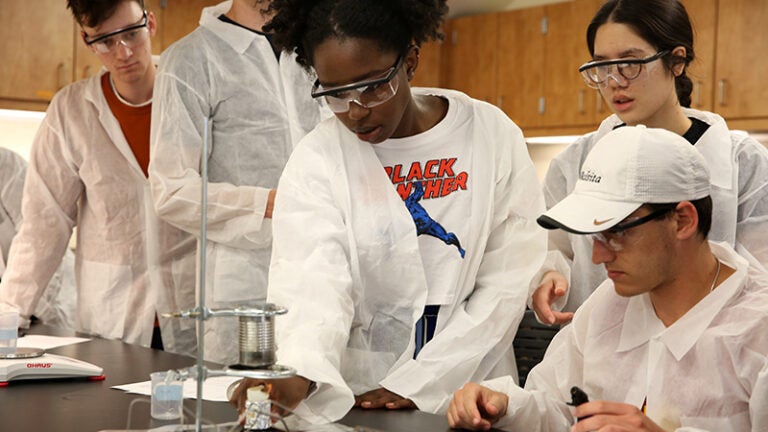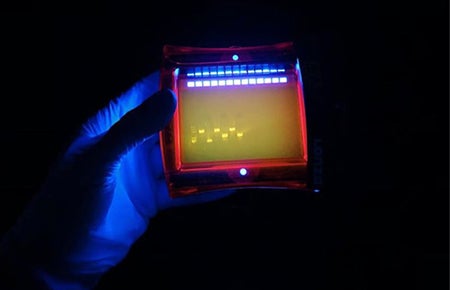
Students learn the science of food and cooking in general education course
Who doesn’t love a beautifully browned baguette fresh out of the oven?
With apologies to the gluten intolerant, the bread’s appealing crusty finish is the result of a chemical reaction between amino acids and sugars, known as the Maillard reaction, which gives browned food its distinctive flavor.
It’s the same chemical reaction that puts a sear on a piece of meat, though not the same as caramelization, which occurs at a higher heat and is the result of sugars browning.
Students in the general education class “The Biology of Food” (BISC 115Lxg), a science course for non-majors taught at USC Dornsife College of Letters, Arts and Sciences, learn these distinctions to understand the fundamentals of biology. They get a broad overview of microbiology, nutrition, biochemistry, genetics and molecular biology from the cellular level to the macro level through the lens of food and cooking.
Why food? There’s nothing more universal, says Grayson Jaggers, assistant professor (teaching) of biological sciences, who teaches the course. “We can all relate to food and health.”
Looking for a reaction
The course combines lectures and labs, which help illustrate the various concepts that Jaggers covers from basic food molecules and tissue structure to fermentation and the biology of sensory receptors.
In one lab experiment, students learn how to calculate calories. Using an instrument called a calorimeter, which measures the heat of chemical reactions, they take turns igniting cheese puffs, popcorn, spinach and other foods in the device’s combustion chamber, which is suspended below a metal container of water. They measure the water’s change in temperature to calculate the number of calories each food item contains.
While learning about these scientific concepts, the class also gives students a way to better understand timely topics in the news such as the presence of genetically modified organisms, or GMOs, in foods, which is a hotly contested issue.
“It’s a buzzword all over the news and in supermarkets,” said Jaggers. “But what does it mean for something to contain GMOs and what does it do in our food? That’s something we also discuss in class.”
As an experiment, students extracted DNA from different foods to test them for the presence of GMOs using a process called electrophoresis. Their tests showed that a popular brand of chips does in fact contain GMOs.

Students use a process called electrophoresis to test different foods for genetically modified organisms, or GMOs. (Photo: Grayson Jaggers.)
Following the GMO lab and lecture, undergraduate Michelle Kim was inspired to seek out some of the literature that Jaggers recommended presenting different arguments on the subject.
“I’m hoping the books Professor Jaggers suggested will help me create my own stance on GMOs,” said Kim, who is majoring in economics, math and history at USC Dornsife.
Jaggers believes the hands-on lab experiences and relatable content helps students better understand how science relates to their everyday lives.
“Biology is a really interesting subject. There’s so much going on that we’re not aware of in terms of how things work,” Jaggers said. “My goal is to demystify it. I want students to have a better understanding of the world around them.”
Biology with a side of cooking
While learning to cook isn’t a direct goal of the course, it’s an added benefit of the curriculum.
In a lab about protein isolation and coagulation, students experiment with ingredients to understand how their proteins are transformed to make different types of cheese. A cheese’s texture and taste depend on the bacteria, enzymes and naturally formed acids that solidify milk proteins and fat.
“I learned how easy it is to make cheese at home,” Kim said. “I don’t know why more people don’t do it.”
Jaggers is himself a home chef experimenting with different dishes, but he remembers when he was an undergraduate looking for advice to prepare the basics.
“I remember calling my mother and asking, ‘How do I cook chicken? What temperature and how long?’” he said. Understanding the science of cooking helped him get a better final product.
Kim, who plans to pursue a career as a teacher, said that she really enjoys connecting technical scientific concepts to the world around her.
“When we talk about the senses and how olfactory nerves in our brain and tongue connect to signal how something tastes, it’s much easier to grasp because of the way we relate our lessons to food,” she said.
“I hope that one day I can make learning as fun, interactive and fulfilling for students that I teach.”
“The Biology of Food” will be offered next in the Spring 2020 semester.
Follow along as students in “The Biology of Food” make cheese on Instagram stories (login required).